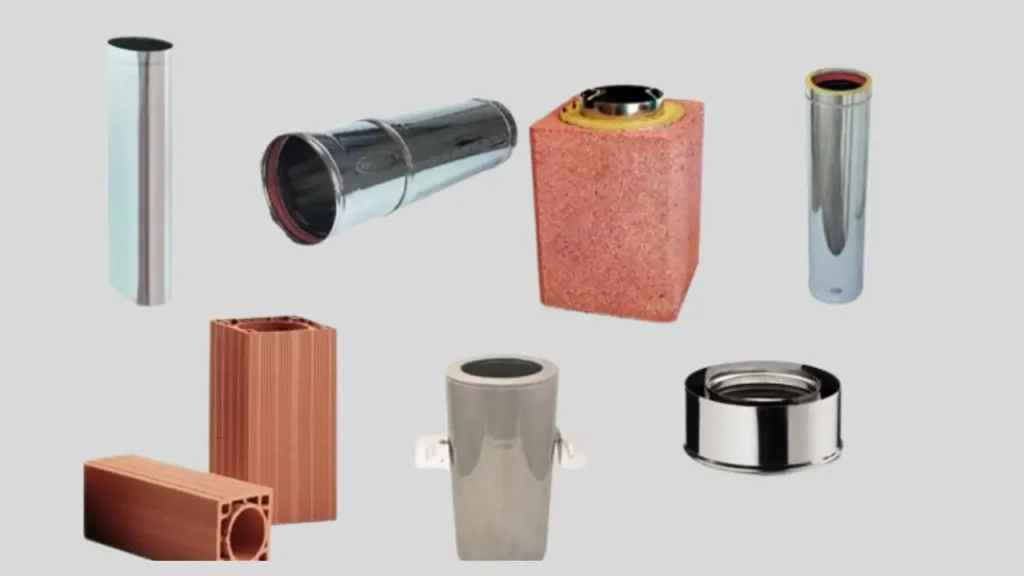Choosing the right chimney pipe is essential for ensuring the safe and efficient operation of your heating appliances. With various types available, from Class A pipes suitable for all fuel types to specialized options like B-Vent for gas appliances, understanding the differences can be overwhelming.
This blog post will explore five distinct types of chimney pipes, detailing their specific applications and benefits, while also providing a handy size chart to guide your installation process.
Whether you’re a seasoned contractor or a homeowner embarking on a DIY project, this guide will simplify your decision-making and help you achieve optimal performance from your chimney system.
Why Choosing the Right Chimney Pipe Matters
Choosing the right chimney pipe is crucial for maintaining a safe and efficient heating system in your home. The chimney pipe plays a vital role in venting out combustion by-products, which helps prevent fire hazards and toxic fume accumulation.
Selecting the appropriate type of chimney pipe whether it’s Class A insulated pipes for wood-burning stoves, B-Vent for gas appliances, or specialized systems for pellet stoves ensures that your heating appliance operates effectively and complies with local building codes.
Understanding the differences between single-wall and double-wall pipes, as well as the importance of insulation, can significantly impact both the performance and safety of your heating setup.
By making informed decisions regarding your chimney pipe choice, you not only enhance the efficiency of your heating system but also contribute to a safer home environment.
See Our Recommendations: Best Durable Chimney Pipes
5 Types of Chimney Pipes
- Class A Chimney Pipe
- Direct Vent Pipe
- Stove Pipe
- Type B Gas Pipe
- Pellet Vent Pipe

1) Class A Chimney Pipe
Class A chimney pipes are designed to vent high-temperature exhaust from wood-burning appliances, including fireplaces, stoves, and boilers. They are often referred to as double-wall or triple-wall pipes due to their construction.
Key Features
- Typically features a stainless steel inner flue and a galvanized or stainless steel outer shell.
- Contains ceramic or fiberglass insulation that keeps the outer wall cooler, reducing the risk of fire hazards.
- Suitable for various fuel types (wood, coal, oil) and can be used in both residential and commercial settings.
- Generally requires a clearance of 2 inches from combustibles.
Specifications Chart
| Diameter (inches) | Length (feet) | Insulation Type | Clearance to Combustibles (inches) | Typical Applications |
|---|---|---|---|---|
| 5 | 3-10 | Ceramic/Fiberglass | 2 | Wood stoves, fireplaces |
| 6 | 3-10 | Ceramic/Fiberglass | 2 | Wood stoves, fireplaces |
| 8 | 3-10 | Ceramic/Fiberglass | 2 | Wood stoves, boilers |
| 10 | 3-10 | Ceramic/Fiberglass | 2 | Larger wood-burning appliances |
2) Direct Vent Pipe
Direct vent pipes are specifically designed for gas appliances that require fresh air for combustion. They feature a coaxial design that allows for the intake of air and the expulsion of exhaust gases.
Key Features
- Comprises an inner pipe for exhaust and an outer pipe for intake air.
- Can be installed vertically or horizontally; however, installation must adhere to specific clearance requirements.
- Provides a sealed system that enhances energy efficiency by preventing heat loss.
Specifications Chart
| Diameter (inches) | Length (feet) | Clearance to Combustibles (inches) | Typical Applications |
|---|---|---|---|
| 3 | 3-10 | 1 (vertical), 3 (horizontal top), 1 (horizontal bottom) | Gas fireplaces |
| 4 | 3-10 | 1 (vertical), 3 (horizontal top), 1 (horizontal bottom) | Gas furnaces |
| 5 | 3-10 | 1 (vertical), 3 (horizontal top), 1 (horizontal bottom) | Direct vent gas appliances |
3) Stove Pipe
Stove pipes connect wood-burning stoves or other heating appliances to the chimney system. They are available in single-wall and double-wall configurations.
Key Features
- Usually made from stainless steel or galvanized steel.
- Single-wall stove pipes require greater clearance to combustibles compared to double-wall options, which provide better insulation.
- Primarily used for wood-burning stoves but can also be used with other solid fuel appliances.
Specifications Chart
| Diameter (inches) | Length (feet) | Wall Type | Clearance to Combustibles (inches) | Typical Applications |
|---|---|---|---|---|
| 6 | 3-10 | Single-Wall | 18 | Wood-burning stoves |
| 6 | 3-10 | Double-Wall | 6 | Wood-burning stoves |
| 8 | 3-10 | Single-Wall | 18 | Larger wood-burning appliances |
| 8 | 3-10 | Double-Wall | 6 | Larger wood-burning appliances |
4) Type B Gas Pipe
Type B gas pipes are specifically designed for venting gas appliances. They are constructed with double walls to safely expel flue gases while maintaining efficiency.
Key Features
- Inner wall typically made of aluminum or stainless steel; outer wall is usually galvanized steel.
- Designed specifically for gas appliances with safety ratings ensuring compliance with building codes.
- Requires specific clearances based on installation type.
Specifications Chart
| Diameter (inches) | Length (feet) | Clearance to Combustibles (inches) | Typical Applications |
|---|---|---|---|
| 4 | 3-10 | 1 | Gas water heaters |
| 5 | 3-10 | 1 | Gas furnaces |
| 6 | 3-10 | 1 | Gas fireplaces |
5) Pellet Vent Pipe
Pellet vent pipes are designed specifically for pellet-fueled stoves. They ensure proper venting of exhaust gases while allowing fresh air intake.
Key Features
- Often made from stainless steel or other corrosion-resistant materials.
- Available in various configurations including straight pipes, elbows, and tees for versatile installations.
- Provides a sealed system that minimizes heat loss and maximizes performance.
Specifications Chart
| Diameter (inches) | Length (feet) | Clearance to Combustibles (inches) | Typical Applications |
|---|---|---|---|
| 3 | 3-10 | 1 | Pellet stoves |
| 4 | 3-10 | 1 | Pellet stoves |
| 5 | 3-10 | 1 | Larger pellet stoves |
Handy Chimney Pipe Size Chart
| Appliance Type | Pipe Diameter | Vent Height (Min) | Application |
|---|---|---|---|
| Wood Stove | 6-8 inches | 15 feet | Wood-burning fireplaces |
| Pellet Stove | 3-4 inches | 12 feet | Pellet burners |
| Gas Stove | 4-6 inches | 10 feet | Gas appliances |
| Fireplace Insert | 6-8 inches | 12 feet | Inserts for existing units |
| Outdoor Chimney | 8+ inches | 20 feet | Large outdoor systems |
Factors to Consider When Choosing a Chimney Pipe
- Fuel Type
- Different pipes are designed for specific fuels. For example, pellet stove pipes resist acidic byproducts, while Class A pipes handle high temperatures for wood stoves.
- Venting Requirements
- Direct vent systems need sealed pipes, whereas natural draft setups rely on proper sizing and height for effective airflow.
- Local Building Codes
- Always check with local regulations to ensure compliance. Using non-compliant materials can lead to penalties or safety issues.
How to Accurately Measure For the Correct Chimney Pipe Size
To accurately measure for the correct pipe size for your chimney, follow these steps:
Tools Needed
- Soft measuring tape: For measuring around the pipe.
- Caliper: For precise measurements of diameters.
- Calculator: To perform necessary calculations.
Measuring Steps
- Identify the Type of Pipe:
- Check if the pipe is labeled. Many PVC, CPVC, or PEX pipes have their sizes printed on them, which can save time.
- Measure the Outside Diameter:
- Use a caliper to measure the outside diameter directly if possible. This is crucial for male pipes (those without threads) since you need the outside measurement.If a caliper is not available, wrap a soft tape measure around the pipe to find its circumference. Use the formula:
- Measure the Inside Diameter (if applicable):
- For female pipes (those with threads), measure the inside diameter using a caliper. This measures the width of the pipe hole, excluding wall thickness.
- Convert to Nominal Pipe Size:
- After obtaining your diameter measurement, consult a conversion chart to find the nominal pipe size, which is what you will need when purchasing materials. The nominal size does not always match the actual diameter due to manufacturing standards.
Additional Considerations for Chimney Flues
When sizing chimney flues specifically, ensure that:
- The flue diameter matches or exceeds the appliance’s flue outlet size as recommended by the manufacturer.
- Common sizes include:
- Ø200 mm for fireplaces with openings up to 500 x 550 mm.
- Ø150 mm for closed appliances up to 30 kW rated output.
FAQs
What is the most common type of chimney pipe for wood stoves?
Class A chimney pipes are the most popular for wood stoves due to their high-temperature resistance.
Can I use the same chimney pipe for gas and pellet stoves?
No, each fuel type requires specific pipe designs to handle unique byproducts.
How do I measure my chimney pipe size accurately?
Measure the appliance’s flue collar diameter and consult the manufacturer’s guidelines for proper sizing.
What are the risks of using an improperly sized chimney pipe?
Improper sizing can lead to smoke buildup, reduced efficiency, and even fire hazards.
Do chimney pipes require regular maintenance?
Yes, cleaning and inspections are essential to prevent blockages and maintain safety.
Affiliate Disclosure: Fireplaceadviser.com is a participant in the Amazon Services LLC Associates Program. We may earn a commission when you click on certain links on this site and purchase.

Hello!! I am Jamal Khan. I often fix my home electric heaters and gas stove problems and research the common issues in the heating units to improve my knowledge and expertise. The aim of establishing fireplaceadviser.com is to share my expertise and knowledge with my audience.












